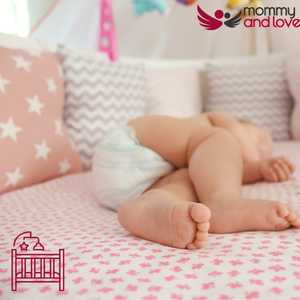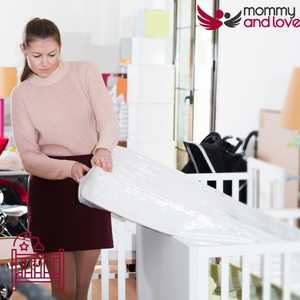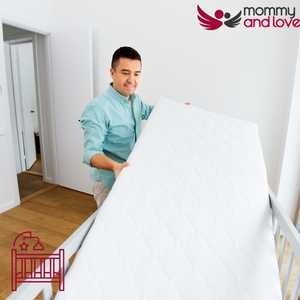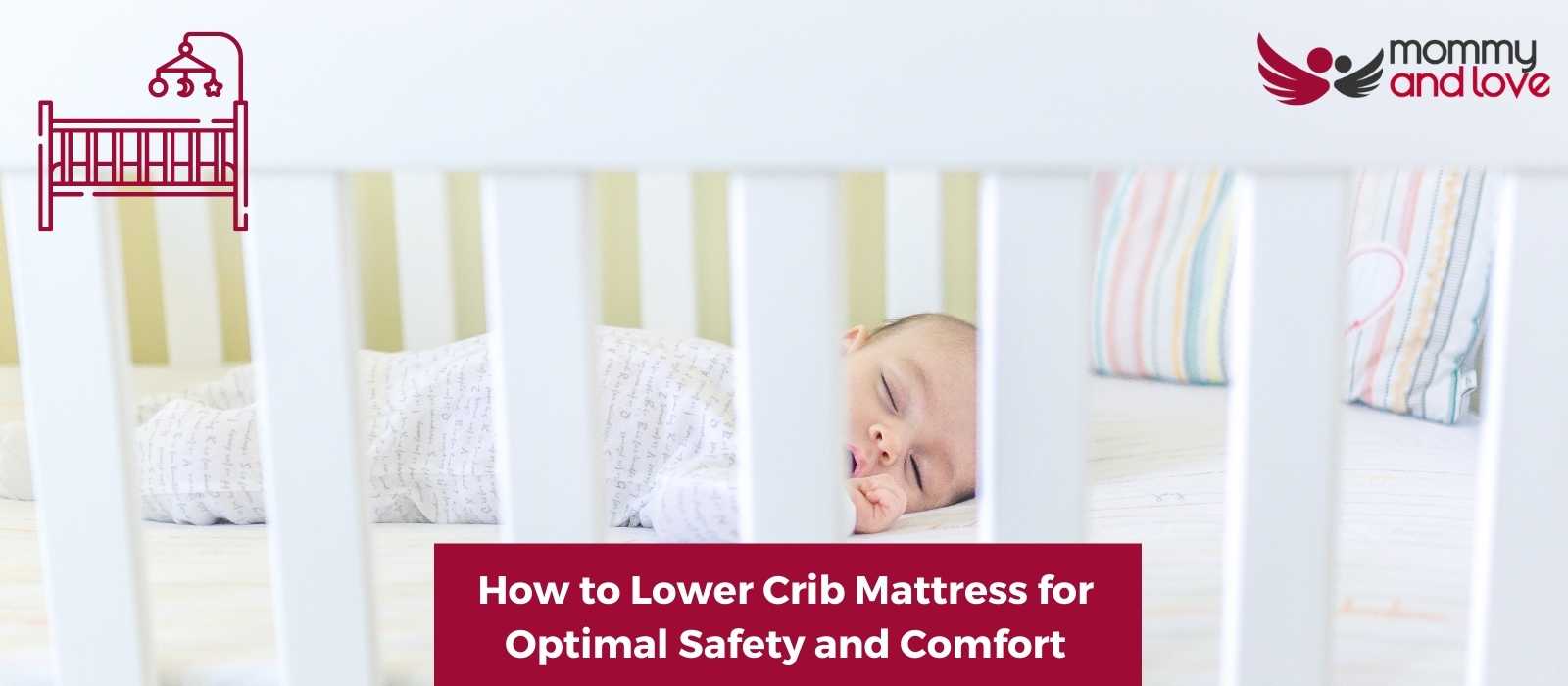Most parents give little thought to the height of their baby’s crib mattress. However, making a few simple adjustments can make all the difference in terms of your child’s comfort.
There will be times when you need to lower crib mattress of your baby. Most of the time, when you lower your baby’s crib, it’s done for safety reasons. Even if the floor is carpeted, no one wants their baby to fall out of the crib and land on it.
When Should I Lower the Crib Mattress?

As your baby grows, your baby starts to sit up, and the baby shows signs of pulling up to standing, it’s time to lower the crib mattress.
For most babies, this is between five and eight months old.
If your baby is particularly small or large, you may need to adjust the mattress sooner or later. Watch for these signs that it’s time to make the switch. And remember, when in doubt, always err on the side of safety.
How to Lower the Baby’s Crib Mattress Height
Here’s how you lower your baby’s crib mattress to your desired setting.
First, remove all bedding and sheets from the baby’s crib. This will give you easy access to the mattress itself.
Next, lower the mattress to your desired setting. You can do this by removing the mattress support and simply lowering the mattress down.
Once you’ve lowered the crib’s mattress, it’s important to test the baby’s mattress out. Make sure that it’s stable and doesn’t wobble or move around too much for the safety of your sleeping baby.
Additionally, there should be no crib bumpers or bumper pads around for optimal crib safety and to prevent crib-related accidents such as children falling out of their cribs. and hitting their head on the floor.
Finally, put the bedding and sheets back on. Keep your baby’s crib clear from any extra blankets, stuffed animals, baby books and pillows for the safest sleep for your baby. Follow the assembly instructions if you removed some parts other than the mattress.
And that’s it! Lowering your baby’s crib is not as hard as you think it was. You’ve successfully lowered the crib mattress to your desired setting.
What Level Should a Crib Mattress Be?

Many parents put their cribs at the highest level when their baby is born. This is because it’s easier to pick up a newborn from a high crib.
But once your baby grows and becomes more active, you’ll want to lower your crib.
The AAP says that when the crib is at its highest setting, the mattress should be at least 26 inches from the side rail. When your child is taller than 35 inches, the AAP says they shouldn’t sleep in a crib with walls.
Here’s a breakdown of the different height settings of a standard baby crib:
Highest Setting
- The highest crib setting is usually best for newborns to have a good night’s sleep.
- For babies under 5 months old
- Baby is immobile
- Babies are usually sleeping in a sleep sack or swaddle.
Middle Setting
- 6-8 months old
- The baby is mobile but cannot stand without assistance.
Lowest Setting
- The lowest setting is recommended for babies age 8 months and older.
- The baby can pull to a standing position.
Toddler Bed
- When your baby’s height reaches 35 inches or taller
Can You Lower a Crib Mattress to the Floor?
You might be wondering if lowering your baby’s crib to the floor is possible. The answer is, that it depends.
If the mattress is not already at its lowest crib setting or at the lowest point, you might be able to take off the bottom of the crib and lower crib mattress all the way to the floor. This can work as long as there is no space between the top of the mattress and the bottom of the crib rails.
However, if there is a space between the mattress and the rails, you will not be able to lower the mattress level all the way to the floor.
So, if you’re wondering whether or not you can lower a crib mattress to the floor, it really depends on your specific situation.
What Is the Crib Height Recommendation?
The crib height depends on your baby’s age, abilities and size. A recent study says that new parents should leave at least 26 inches between the top of the crib rail and the bottom of the crib mattress. This is from the bottom of the crib mattress, which, depending on the brand you choose, can be anywhere from five and a half to six inches thick.
The reason for this recommendation is that if the crib is too high, it may be easy for your baby to climb out and hurt themselves. If the crib is too low, it may be difficult for you to reach in and pick up your baby without straining your back.
The best way to know if your crib is at the correct height is to measure from the floor to the top of the rail. If it is less than 26 inches, you may want to consider adjusting it. You can do this by either removing some of the slats from the bottom of the crib or by using blocks to raise the entire crib up. Just make sure that whatever you use is sturdy and won’t tip over easily.
Crib Mattress Guidelines

When it comes to crib mattress safety, there are a few key things you need to keep in mind.
Here are some guidelines to help you choose the best crib mattress for your baby and ensure your baby’s safety while they sleep.
What Certifications Should a Baby Mattress Have?
A baby mattress should have the following certifications: Greenguard Gold Certification, JPMA Certification, CertiPUR-US Certification, and Global Organic Textile Standard (GOTS).
These certifications ensure that the mattress is safe for your baby to sleep on. Additionally, they certify that the materials used in the mattress are of high quality and free of harmful chemicals. With these certifications, you can be sure that your baby is sleeping on a safe and comfortable mattress.
Can I Stack Two Crib Mattresses?
The simple answer is no. You cannot stack two crib mattresses on top of each other. Even though we can see why you might want to, most cribs are made to hold only one mattress.
Crib mattresses are designed to be firm and not sag in the middle. When you stack two mattresses, the bottom mattress will start to sag in the middle and create a dip. This could cause your baby to roll into this dip and get stuck, which is a serious safety hazard for breathing.
So if you’re tight on space or trying to save money by using two mattresses, we don’t recommend it. It’s simply not worth the risk. Stick to using one crib mattress and make sure it fits snugly in your crib. This will ensure that your baby is safe and comfortable while they sleep.
Why Does Baby Crib Mattress Height Matter?
When you become a parent, there are a million things to worry about. But one of the most important things you can do to keep your baby safe is to pay attention to their crib mattress height.
Most parents don’t realize that the height of the mattress setting in the crib can be just as important to save a baby’s life as the other features, like the rails. If the mattress is too high and your baby can sit up on their own, they could fall out and hurt themselves. You might even have to rush them to the emergency room when this completely avoidable accident happens.
That’s why it’s important to lower the mattress to the middle setting before your baby can sit up on their own.
So next time you’re putting your baby down for a nap, take a minute to check the crib height. It could be the difference between a safe sleep and a nightmare.
Why Raise the Crib Mattress?
There are several reasons you might want to raise your crib mattress.
One reason is if your baby has reflux. When the mattress is raised, it can help reduce the amount of acid that comes back up.
Another reason is if your baby is congested. Raising the head of the bed can help clear congestion and make it easier for your baby to breathe.
Finally, raising the crib mattress can give your baby more mobility. If your baby is starting to sit up or stand, having a raised mattress will give them something to push against. This can help them learn to pull themselves up and eventually start taking steps.
At What Age Do You Transition From Crib to Toddler Bed?
So, at what age does a baby outgrow a crib? Most parents transition their child from a crib to a toddler bed between the ages of 18 months and 24 months. The age at which you transition your infant is really a personal decision, and there is no “right” time to do it.
Many factors can influence your decision, including your baby’s growth, sleeping habits, development, and temperament.
If your child is still sleeping well in his or her crib, there is no rush to transition to a bed. In fact, some children do better with the stability and security of a crib until they are a bit older. If your child is climbing out of the crib or seems cramped in it, it might be time to make the switch.
The important thing is to make sure that your child feels safe and secure in his or her new bed. Be prepared for a few nights of adjustment as your little one gets used to the new sleeping arrangement. With a little patience and understanding, the transition from a crib to a toddler bed can be smooth and enjoyable for both you and your child.
Conclusion
So, how to lower the crib mattress? It’s pretty simple. Start by choosing the height of the crib mattress, remove any beddings, fitted sheets and mattress protector, make the adjustments to the mattress setting, test the lowered mattress and then put all beddings and sheets back on the mattress.
Always use common sense when making the decision to lower the crib mattress height – if something doesn’t feel safe or comfortable to you or your baby, don’t hesitate to reach out for advice from your pediatrician or another parenting expert.




